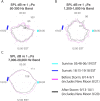Hurricane impacts on a coral reef soundscape
- PMID: 33626054
- PMCID: PMC7904201
- DOI: 10.1371/journal.pone.0244599
Hurricane impacts on a coral reef soundscape
Erratum in
-
Correction: Hurricane impacts on a coral reef soundscape.PLoS One. 2021 Oct 6;16(10):e0258456. doi: 10.1371/journal.pone.0258456. eCollection 2021. PLoS One. 2021. PMID: 34614037 Free PMC article.
Abstract
Soundscape ecology is an emerging field in both terrestrial and aquatic ecosystems, and provides a powerful approach for assessing habitat quality and the ecological response of sound-producing species to natural and anthropogenic perturbations. Little is known of how underwater soundscapes respond during and after severe episodic disturbances, such as hurricanes. This study addresses the impacts of Hurricane Irma on the coral reef soundscape at two spur-and-groove fore-reef sites within the Florida Keys USA, using passive acoustic data collected before and during the storm at Western Dry Rocks (WDR) and before, during and after the storm at Eastern Sambo (ESB). As the storm passed, the cumulative acoustic exposure near the seabed at these sites was comparable to a small vessel operating continuously overhead for 1-2 weeks. Before the storm, sound pressure levels (SPLs) showed a distinct pattern of low frequency diel variation and increased high frequency sound during crepuscular periods. The low frequency band was partitioned in two groups representative of soniferous reef fish, whereas the high frequency band represented snapping shrimp sound production. Daily daytime patterns in low-frequency sound production largely persisted in the weeks following the hurricane. Crepuscular sound production by snapping shrimp was maintained post-hurricane with only a small shift (~1.5dB) in the level of daytime vs nighttime sound production for this high frequency band. This study suggests that on short time scales, temporal patterns in the coral reef soundscape were relatively resilient to acoustic energy exposure during the storm, as well as changes in the benthic habitat and environmental conditions resulting from hurricane damage.
Conflict of interest statement
The authors have declared that no competing interests exist.
Figures









Similar articles
-
Hurricane Irma Linked to Coral Skeletal Density Shifts on the Florida Keys Reef Tract.Integr Comp Biol. 2024 Oct 28;64(4):1064-1077. doi: 10.1093/icb/icae128. Integr Comp Biol. 2024. PMID: 39104226 Free PMC article.
-
The Curious Acoustic Behavior of Estuarine Snapping Shrimp: Temporal Patterns of Snapping Shrimp Sound in Sub-Tidal Oyster Reef Habitat.PLoS One. 2016 Jan 13;11(1):e0143691. doi: 10.1371/journal.pone.0143691. eCollection 2016. PLoS One. 2016. PMID: 26761645 Free PMC article.
-
Habitat degradation negatively affects auditory settlement behavior of coral reef fishes.Proc Natl Acad Sci U S A. 2018 May 15;115(20):5193-5198. doi: 10.1073/pnas.1719291115. Epub 2018 Apr 30. Proc Natl Acad Sci U S A. 2018. PMID: 29712839 Free PMC article.
-
Actively soniferous tropical reef fishes are diverse, vulnerable, and valuable.J Fish Biol. 2025 Apr;106(4):990-995. doi: 10.1111/jfb.16030. Epub 2024 Dec 16. J Fish Biol. 2025. PMID: 39681114 Free PMC article. Review.
-
Noise pollution on coral reefs? - A yet underestimated threat to coral reef communities.Mar Pollut Bull. 2021 Apr;165:112129. doi: 10.1016/j.marpolbul.2021.112129. Epub 2021 Feb 12. Mar Pollut Bull. 2021. PMID: 33588103 Review.
Cited by
-
Correction: Hurricane impacts on a coral reef soundscape.PLoS One. 2021 Oct 6;16(10):e0258456. doi: 10.1371/journal.pone.0258456. eCollection 2021. PLoS One. 2021. PMID: 34614037 Free PMC article.
References
-
- Lercari D, Defeo O, Ortega L, Orlando L, Gianelli I, Celentano E. Long-term structural and functional changes driven by climate variability and fishery regimes in a sandy beach ecosystem. Ecological Modelling. 2018; 368:41–51. 10.1016/j.ecolmodel.2017.11.007 - DOI
Publication types
MeSH terms
Associated data
LinkOut - more resources
Full Text Sources
Other Literature Sources
Research Materials

